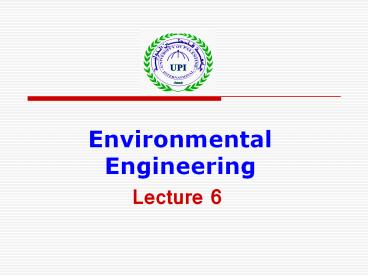Environmental Engineering - PowerPoint PPT Presentation
1 / 23
Title:
Environmental Engineering
Description:
... pre-chlorination PRE-TREATMENT OF WATER ... 2.5 to 6m in depth Sedimentation tank design Key parameters ... Sedimentation Tank Circular ... – PowerPoint PPT presentation
Number of Views:120
Avg rating:3.0/5.0
Title: Environmental Engineering
1
- Environmental Engineering
- Lecture 6
2
Sources of Drinking Water
- Rivers upland and lowland
- Lakes and reservoirs
- Groundwater aquifers
- Sea water (Desalination)
3
WATER TREATMENT PROCESSES
4
WATER TREATMENT PROCESSES
5
Selection of Treatment Process
6
PRE-TREATMENT OF WATER
- Steps required before standard treatment
processes - Screening
- Storage, equalization
- Aeration
- Chemical pre-treatment pre-chlorination
7
PRE-TREATMENT OF WATERScreening
- Coarse Screening
- typically inclined bars of 25 mm diameter and 100
mm spacing - prevent large floating material
- Raking is facilitated by the inclination of the
bars. - Velocities are usually limited to about 0.5 mls
through the screens - Fine screens
- fine screens are fitted after the coarse screens
if storage is not provided, - If there is storage then fine screens are placed
at the outlet of the storage tanks. - typically mesh with openings about 6 mm diameter
- circular drum type or a traveling belt
- Micro screening.
- the mesh openings range from 20 to 40 µm.
- used only as the main (physical) treatment
process for relatively uncontaminated waters.
8
PRE-TREATMENT OF WATER Storage and Equalization
- Storage
- Serve as a safety line in the event of pollution.
- Also serve as reservoirs in time of low supply
- Should be equivalent to 7 to 10 days of the
average water demand - This period is good for settling and adequate to
reduce most pathogens by exposure to daylight - Storage time of about 12h is commonly used to
reduce pumping costs and balance the demand - Equalization
- Provide an 'equal' (or consistent) flow to the
plant
9
Equalization Example
Design the size of an equalization tank to
balance flow rates from a municipal wastewater as
given in columns (1) and (2)
10
PRE-TREATMENT OF WATER Aeration
- Aeration is the supply of oxygen from the
atmosphere to water to effect beneficial changes
in the quality of the water. - It is a common treatment process for groundwater
and less common for surface waters. Aeration is
used - To release excess H2S gas which may cause
undesirable tastes and odors. - To release excess CO2 which may have corrosive
tendencies on concrete materials. - To increase the O2 content of water in the
presence of undesirable tastes due to algae
(fishy smell), - To increase the O2 content of water which may
have negative taste, color and stain properties
due to the presence of iron and manganese in
solution. The addition of oxygen assists the
precipitation of iron and manganese. - Aeration can be a simple mechanical process of
spraying water into the air and allowing it to
fall over a series of cascades (waterfalls),
while absorbing or desorbing (stripping) oxygen
in its journey.
11
PRE-TREATMENT OF WATER Pre-chlorination
- Chemical pre-treatment is used to remove
undesirable properties of water (bacteria, algae
or excess color) is a more expensive process than
chemical post-treatment. - Pre-chlorination is used on low turbidity water
with a high coliform count. - The chlorine is injected into the water stream
and over the period that it stays in the settling
tanks, - it oxidizes and precipitates iron and manganese.
- It also causes pathogenic kill and reduces color.
- Doses as much as 5 mg/l are used,
- Water authorities tend to use pre-chlorination at
times of the year when the surface water supply
is likely to be polluted from agricultural or
industrial sources or when excess organic matter
is transported
12
PRIMARY-TREATMENT OF WATER
- Standard treatment is the set of unit processes
that reduce color, turbidity and particulate
impurities to acceptable levels - Standard treatment consists of the following unit
processes - Sedimentation
- Coagulation and flocculation
- Sedimentation of flocculent particles
- Filtration
13
PRIMARY-TREATMENT OF WATERSedimentation
- Sedimentation by definition is the solid-liquid
separation using gravity settling to remove
suspended solids' (Reynolds, 1982). - In water treatment, sedimentation processes used
are - Type L to settle out discrete non-flocculent
particles in a dilute suspension. - Type n to settle out flocculent panicles in a
dilute suspension - Type L Settling tanks are of two types
- Rectangular
- length width ratio of 2 and a depth of the order
of 1.5 to 6m. - Circular
- Dimensions typically are 10 to 50 m in diameter
and 2.5 to 6m in depth
14
Rectangular Sedimentation Tank
15
Circular Sedimentation Tank
16
Sedimentation tank design
- Key parameters and typical values in the design
of settling tanks - Surface overflow rate
- 20-35 m3/day/m2
- Detention time
- 2-8 hours
- Weir overflow rate
- 150-300 m3/day/m
17
Sedimentation tank design
- Stokes law for settling velocity
18
Sedimentation tank design
- Stokes law for settling velocity
19
Sedimentation tank design
20
Sedimentation tank design
Surface overflow rate, Same for circular tanks
Surface area
21
Sedimentation tank designexample
22
Sedimentation tank designexample
23
Sedimentation tank designexample
Compare?































